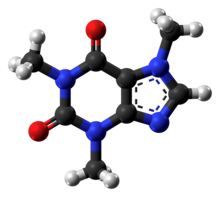ক্যাফেইন
ক্যাফেইন তিক্ত স্বাদের পিউরিন মিথাইলজ্যান্থিন এলকালয়েডের সাদা স্ফটিক এবং রাসায়নিকভাবে ডিএনএ তে অবস্থিত এডেনিন ও গুয়ানিন এর সাথে সাদৃশ্যপূর্ণ। এটা দক্ষিণ আমেরিকার অল্পকিছু গাছের বীজ ও পাতায় পাওয়া যায়। গাছগুলোর আদিভূমি দক্ষিণ আমেরিকা হলেও এখন সারা বিশ্বেই পাওয়া যায়। ক্যাফেইনের বহুল পরিচিত উৎস হচ্ছে কফি এরাবিকা নামক কফি গাছে বীজ যা সাধারনত “বিন” নামে পরিচিত। ক্যাফেইন সমৃদ্ধ পানীয় পানে ঝিমুনি ভাব কেটে গিয়ে শক্তি মাত্রা বৃদ্ধি পায়। ইনফিউশান বা অন্তঃপাতন পদ্ধতিতে গাছ থেকে ক্যাফেইন সংগ্রহ করা হয়। আমেরিকায় কফি পানীয় খুবই জনপ্রিয়। আমেরিকার শতকরা ৯০% প্রাপ্তবয়স্ক জনসাধারণ প্রতিদিন কফি পান করে।[১০]

ক্যাফেইনকে CNS বিবর্ধক হিসেবে শনাক্ত করা হয়েছে।[১১] বলা যায় এটি পৃথিবীর বুকে সব থেকে বেশি ব্যবহৃত psychoactive ড্রাগ বা মাদক। কিন্তু অন্যান্য মাদকের মত এটি অবৈধ নয়। সারা বিশ্বেই এটি পানীয় হিসেবে গ্রহণযোগ্যতা পেয়েছে। এক কাপ কফিতে (সাত আউন্স) আনুমানিক ৮০-১৭৫ মিলিগ্রাম ক্যাফেইন থাকে।[১২]
ব্যবহার
সম্পাদনাক্যাফেইনও একটি উদ্দীপক এলকালয়েড যা চা ও কফির উদ্দীপক উপাদান। ক্লান্তি ও ঝিমুনিতে চা বা কফি পান (ক্যাফেইন পান) শরীরকে চাঙ্গা করে তোলে। ক্যাফেইন পাকস্থলী হতে রক্তে প্যারাসিটামলের শোষণ বাড়ায়। তাই ক্যাফেইন যুক্ত প্যারাসিটামল শুধু প্যারাসিটামলের চেয়ে দ্রুত কাজ করে।[১৩]
প্বার্শপ্রতিক্রিয়া
সম্পাদনাক্যাফেইন অল্পতেই বিরক্ত হওয়া, মাথা ঘোরা, দুশ্চিন্তা বাড়া, জলশূন্যতা, মাথা ব্যথা, প্যালপিটিশন বা পেট ব্যথারও কারণ হতে পারে। তাই এসবের প্রভাব কমাতে কফির সাথে পর্যাপ্ত জল পান করতে হয়।[১৪]
কফি সম্পর্কিত বই
সম্পাদনা- Bersten, Ian (১৯৯৯)। Coffee, Sex & Health: A history of anti-coffee crusaders and sexual hysteria। Sydney: Helian Books। আইএসবিএন 0-9577581-0-3।
- Pendergrast, Mark (২০০১) [1999]। Uncommon Grounds: The History of Coffee and How It Transformed Our World। London: Texere। আইএসবিএন 1-58799-088-1।
বহিঃসংযোগ
সম্পাদনা- GMD MS Spectrum
- The Consumers Union Report on Licit and Illicit Drugs, Caffeine-Part 1 Part 2
- Caffeine: ChemSub Online
- Caffeine at The Periodic Table of Videos (University of Nottingham)
- Caffeine International Chemical Safety Cards
- Mayo Clinic staff (৩ অক্টোবর ২০০৯)। "Caffeine content for coffee, tea, soda and more"। Mayo Clinic। সংগ্রহের তারিখ ৮ নভেম্বর ২০১০।
তথ্যসূত্র
সম্পাদনা- ↑ ক খ Introduction to Pharmacology (third সংস্করণ)। Abingdon: CRC Press। ২০০৭। পৃষ্ঠা 222–223। আইএসবিএন 978-1-4200-4742-4।
- ↑ ক খ Malenka RC, Nestler EJ, Hyman SE (২০০৯)। "Chapter 15: Reinforcement and Addictive Disorders"। Sydor A, Brown RY। Molecular Neuropharmacology: A Foundation for Clinical Neuroscience (2nd সংস্করণ)। New York: McGraw-Hill Medical। পৃষ্ঠা 375। আইএসবিএন 978-0-07-148127-4।
Long-term caffeine use can lead to mild physical dependence. A withdrawal syndrome characterized by drowsiness, irritability, and headache typically lasts no longer than a day. True compulsive use of caffeine has not been documented.
- ↑ ক খ উদ্ধৃতি ত্রুটি:
<ref>ট্যাগ বৈধ নয়;Clinical addiction & dependenceনামের সূত্রটির জন্য কোন লেখা প্রদান করা হয়নি - ↑ ক খ American Psychiatric Association (২০১৩)। "Substance-Related and Addictive Disorders" (পিডিএফ)। American Psychiatric Publishing। পৃষ্ঠা 1–2। ১৫ আগস্ট ২০১৫ তারিখে মূল (পিডিএফ) থেকে আর্কাইভ করা। সংগ্রহের তারিখ ১০ জুলাই ২০১৫।
Substance use disorder in DSM-5 combines the DSM-IV categories of substance abuse and substance dependence into a single disorder measured on a continuum from mild to severe. ... Additionally, the diagnosis of dependence caused much confusion. Most people link dependence with "addiction" when in fact dependence can be a normal body response to a substance. ... DSM-5 will not include caffeine use disorder, although research shows that as little as two to three cups of coffee can trigger a withdrawal effect marked by tiredness or sleepiness. There is sufficient evidence to support this as a condition, however it is not yet clear to what extent it is a clinically significant disorder.
- ↑ উদ্ধৃতি ত্রুটি:
<ref>ট্যাগ বৈধ নয়;pmid15448977নামের সূত্রটির জন্য কোন লেখা প্রদান করা হয়নি - ↑ ক খ গ ঘ ঙ চ ছ জ "Caffeine"। DrugBank। University of Alberta। ১৬ সেপ্টেম্বর ২০১৩। সংগ্রহের তারিখ ৮ আগস্ট ২০১৪।
- ↑ ক খ গ Poleszak E, Szopa A, Wyska E, Kukuła-Koch W, Serefko A, Wośko S, Bogatko K, Wróbel A, Wlaź P (ফেব্রুয়ারি ২০১৬)। "Caffeine augments the antidepressant-like activity of mianserin and agomelatine in forced swim and tail suspension tests in mice"। Pharmacological Reports। 68 (1): 56–61। ডিওআই:10.1016/j.pharep.2015.06.138। পিএমআইডি 26721352।
- ↑ "Caffeine"। Pubchem Compound। NCBI। সংগ্রহের তারিখ ১৬ অক্টোবর ২০১৪।
Boiling Point
178 °C (sublimes)
Melting Point
238 DEG C (ANHYD) - ↑ "Caffeine"। ChemSpider। Royal Society of Chemistry। সংগ্রহের তারিখ ১৬ অক্টোবর ২০১৪।
Experimental Melting Point:
234–236 °C Alfa Aesar
237 °C Oxford University Chemical Safety Data
238 °C LKT Labs [C0221]
237 °C Jean-Claude Bradley Open Melting Point Dataset 14937
238 °C Jean-Claude Bradley Open Melting Point Dataset 17008, 17229, 22105, 27892, 27893, 27894, 27895
235.25 °C Jean-Claude Bradley Open Melting Point Dataset 27892, 27893, 27894, 27895
236 °C Jean-Claude Bradley Open Melting Point Dataset 27892, 27893, 27894, 27895
235 °C Jean-Claude Bradley Open Melting Point Dataset 6603
234–236 °C Alfa Aesar A10431, 39214
Experimental Boiling Point:
178 °C (Sublimes) Alfa Aesar
178 °C (Sublimes) Alfa Aesar 39214 - ↑ Lovett R (২৪ সেপ্টেম্বর ২০০৫)। "কফি: শয়তানের পানীয়?"। New Scientist (2518)। ১১ অক্টোবর ২০০৮ তারিখে মূল থেকে আর্কাইভ করা। সংগ্রহের তারিখ ২৮ ডিসেম্বর ২০১৪। (সদস্যতা নেয়া প্রয়োজন (সাহায্য))।
- ↑ Nehlig A, Daval JL, Debry G (১৯৯২)। "Caffeine and the central nervous system: mechanisms of action, biochemical, metabolic and psychostimulant effects"। Brain Res. Brain Res. Rev.। 17 (2): 139–70। ডিওআই:10.1016/0165-0173(92)90012-B। পিএমআইডি 1356551।
- ↑ How much caffeine is in your daily habit? – MayoClinic.com
- ↑ Rahman, Mahmudur (২০১৫)। Pharmaceutical Dosage Forms: Capsule। Germany: LAP LAMBERT Academic Publishings। আইএসবিএন 978-3-659-78314-2।
- ↑ Champe, Pamela (২০০৮)। Lippincott's Illustrated Reviews: Biochemistry, 4th ed.। Baltimore: Lippincott Williams & Wilkins। আইএসবিএন 9780781769600।

